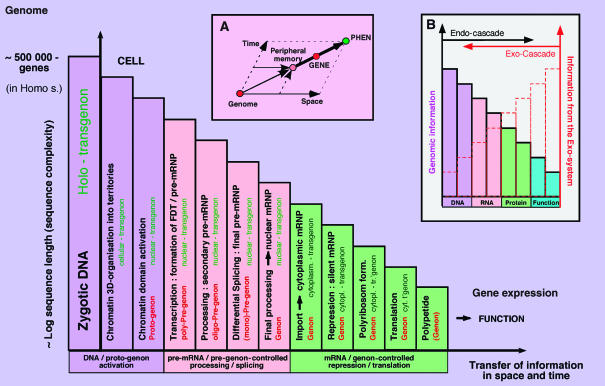Figure 1.
The Cascade of Regulation (Scherrer, 1967, 1980): The information content of the zygotic genome is gradually reduced to that expressed in a differentiated cell. In Homo sapiens an estimated 500 000 polypeptide-genes are reduced to a few hundred in gradual steps; as few as 3 genes may account for up to 90% protein output, as is the case in red blood cells. The Holo-Cascade (not shown) includes additional steps, leading upstream from the information content of an entire species to that of populations and individuals, and downstream from the polypeptide to the assembled protein including all post-translational modifications (Scherrer, 1980). Under the direction of the holo-genon and holo-transgenon, the genomic information is reduced by DNA rearrangements to that of an individual cell, and then by individual steps to the expression of an individual function, as shown here and outlined in the text. These may include the following (1–2) chromatin modification and activation (protogenon-dependent); (3) transcription and formation of pre-mRNP (pre-genon); (4–6) gradual processing and splicing (pre-genon); (7) export and formation of cytoplasmic mRNP (genon); (8–9) activation (de-repression) of mRNP (genon); (10) translation of mRNA (genon) followed by peptide formation (genon has expired) and gene expression. (A) The spatial transfer of a genomic transcript to RNA processing centres (Iarovaia et al, 2001) and the nuclear periphery and (specific sites in) the cytoplasm (De Conto et al, 1999) induces a delay and, hence, a vector in time. Processing and transport steps may be temporarily interrupted, and lead to considerable delay of expression (up to 30 years in the case of histone mRNA in human oocytes), and the constitution of ‘peripheral memories' (Scherrer, 1974, 1980), from where the gene will be created and/or expressed, eventually. These may be in the form of unspliced (fragmented genes) or finally spliced pre-mRNPs, cytoplasmic mRNPs or miRNA complexes. (B) The genomic information being gradually reduced along the Cascade, information from the external space of the cell and organism plays a gradually increasing function. Highest at the periphery, concerning for example all cell-surface receptor functions, some external instructions may reach the genomic DNA to bring about a physiologic change. This can be conceived as an ‘exo-cascade' as proposed here, ‘infiltrating' the ‘endo-cascade' of gene expression.

